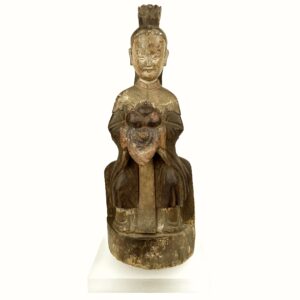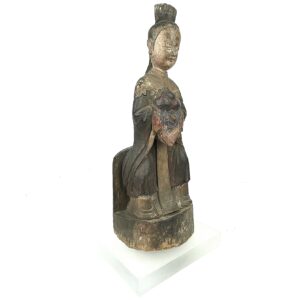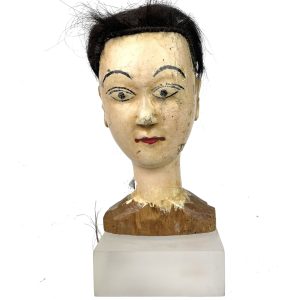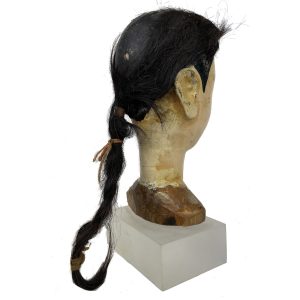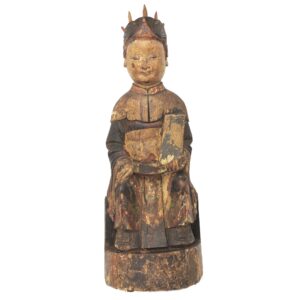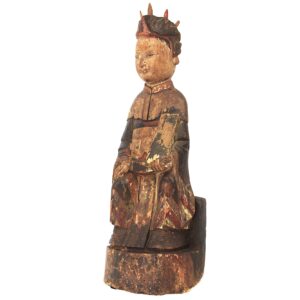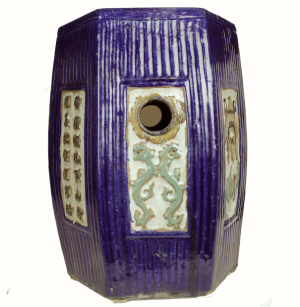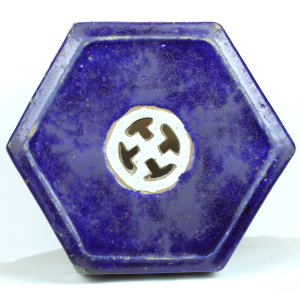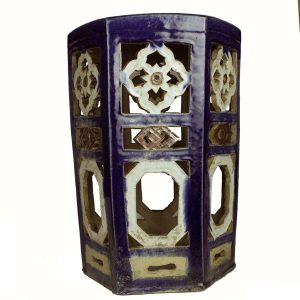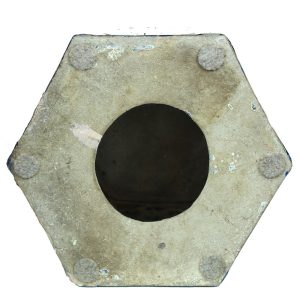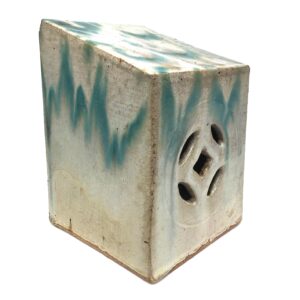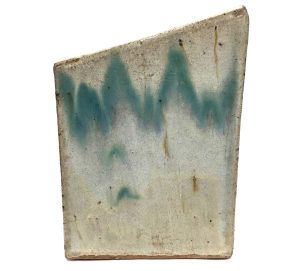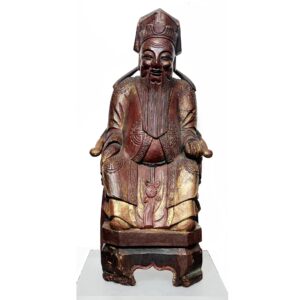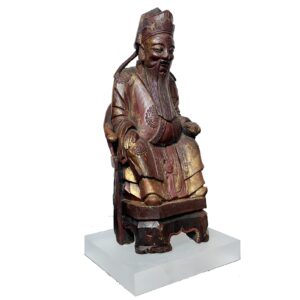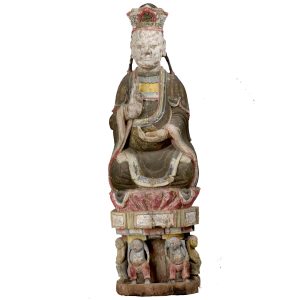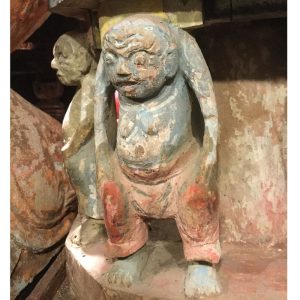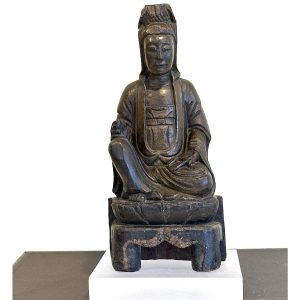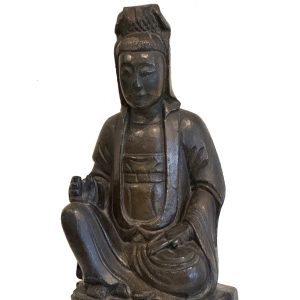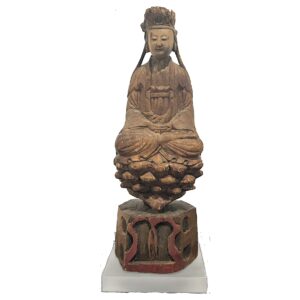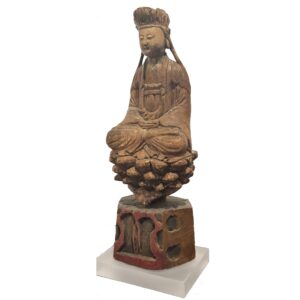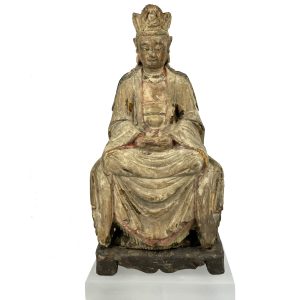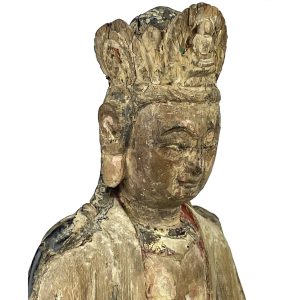Showing 61–72 of 313 results
-


$595.00
Statues of attendants often appear as a pair looking inward and flanking a deity, unless they are very important ones and look straight ahead. They may carry a range of offerings. This antique Chinese woodcarving appears to be a Taoist image likely placed on a home altar along with deities, house gods and ancestors to…
-
Sale!


$295.00 Original price was: $295.00.$195.00Current price is: $195.00.
H: 8.5″ W: 4″ D: 2.75″ | FREE SHIPPING WITHIN CONTINENTAL U.S.!
Antique Chinese puppets were often made in several parts with removable heads. This antique carved head of a beauty has delicately painted features and an animal hair braided down the back. Since there is an area without hair towards the back, she likely originally wore a hat or headdress. A hole on top probably accommodated strings.
-
Sale!


$495.00 Original price was: $495.00.$295.00Current price is: $295.00.
H: 12 ” W:4.3 ” D: 2.25 ” | FREE SHIPPING WITHIN CONTINENTAL U.S.!
Women have played a large role in Taoism as Taoist beliefs are compatible with feminine characteristics like modesty, softness, yielding to the Tao, and non-aggression. Women were welcomed as priests during the start of Taoism. The unusual headdress on this carving has a long necked phoenix, the Chinese “king of birds” who represents virtue, propriety, duty, mercy, and credibility.
-


$1,450.00
This stoneware glazed garden stool was used by a wealthy family reflected in its complex designs, auspicious symbols and its use of so much cobalt blue, a highly prized and expensive mineral paint color normally used sparingly. The pierced side to side circles running through the inside from side to side and the pierced design…
-


$1,450.00
The top design on this stoneware garden stool is a simplified open narcissus with a white and yellow center; it is a symbol of good fortune and prosperity. Below are intertwined double lozenges, followed on the lowest register of by white octagonal shapes and ending with a low orange-yellow rectangle pierced in the center. A…
-
Sale!


$235.00 Original price was: $235.00.$185.00Current price is: $185.00.
H: 7.25″ W: 5″ D: 5″ | FREE SHIPPING WITHIN CONTINENTAL U.S.!
This five-sided Shiwan stoneware pillow with slanted top, open bottom, vibrant glazed surface, and etched coin and diamond design was used for smoking opium as the cool shell cradled the users’ heads and necks and offset the warmth of smoking and the hollow inside stored valuables. We have another which can be paired with it. If a candle is placed inside it emits an amazing shadowy form of a coin, which appealed to those in an opium state.
-
Sale!


$745.00 Original price was: $745.00.$425.00Current price is: $425.00.
H: 10.25” W: 4.75” D: 3.625” | FREE SHIPPING WITHin Continental U.S.!
This beautifully carved God of Wealth (Caishen) is portrayed as are all Taoist deities as an authoritative figure, right hand firmly placed on his knee and left hand holding a tael. His outer robe has decorative borders down the front and carved coins at the shoulders, stomach, and an undergarment is gathered with a floral designed tasseled cord. His well-defined face with incised wrinkles and long beard has a benevolent expression with rounded cheeks and an open mouth, topped by an elaborate official’s hat with ribbon-like extensions. Very fittingly, it is painted with red and gold both associated with wealth.
-


$5,200.00
Carved wood Guanyin images were enormously popular in China’s provincial regions created by local artisans who did not follow proscribed court artistic rules or iconography and integrated elements from Buddhist, Taoist and Popular Folk Religion traditions into a syncretic blend as one of the Great Chinese Goddesses (Irwin). She sits on a raised lotus rising…
-


$495.00
This delicate Mahayana Pure Land Buddhism Guanyin sits in meditation (dhyana mudra) representing concentration and peace hands in lap and legs crossed in lotus position (padmasana). Guanyin’s (Sanskrit Padmapani meaning “born of the lotus”) close association with the lotus is seen on her complex two-part throne. Resting on a footed base, the lotus throne is…
-


$525.00
During the Ming and Qing dynasties, artists created small scale icons of Bodhisattva Guanyin and other deities for private use on a home altar and in local temples and shrines. While more sanctioned images and those made for wealthier devotees were created in porcelain, jade, bronze and ivory, those created for Popular Folk Religion, Taoist…
-


$695.00
H: 14.5” W: 5.5” D: 4.25” | FREE SHIPPING within continental u.s.!
Guanyin’s elegance, compassion and serenity are emphasized in this graceful antique provincial carving. Portrayed in meditation with flowing robes on a majestic three-tiered lotus throne she was designed for personal veneration in a home setting.
-


$1,300.00
H: 13.75” W: 7” D: 4.5” | FOR SHIPPING INFORMATION CONTACT US AT 213-568-3030 or email [email protected]
This delicately detailed Guanyin statue in meditation on a two-tiered backless throne has flowing braids, simple necklace, and voluminous robes indicating her regal status, while her pendulous ears, compassionate downcast eyes, serene contemplative expression, and calm smile symbolize her enlightened status. The image’s distinguishing feature is its deeply carved three-part diadem (crown) centered with a carved Amitabha Buddha on lotus throne surrounded by an aureole.
End of content
End of content

